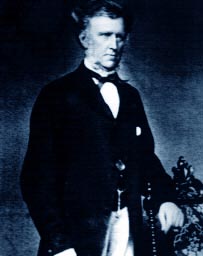
Toodyay, known as Newcastle between 1860 and 1910, is a town on the Avon River in the Wheatbelt region of Western Australia, 85 kilometres (53 mi) north-east of Perth on Ballardong Noongar land. The first European settlement occurred in the area in 1836. After flooding in the 1850s, the townsite was moved to its current location in the 1860s. It is connected by railway and road to Perth. During the 1860s, it was home to bushranger Moondyne Joe.
William Sykes was an English convict, transported to Western Australia for manslaughter.

The Newcastle Gaol Museum is a prison museum on Clinton Street in Toodyay, Western Australia, founded in 1962. The museum records the history of the serial escapee Moondyne Joe and his imprisonment in the "native cell".

The former Toodyay Court House in Toodyay, Western Australia has been used as municipal offices for Toodyay since the 1950s.

West Toodyay was the original location of the town of Toodyay, Western Australia. It is situated in the Toodyay valley, 85 kilometres (53 mi) north east of Perth. The Toodyay valley, discovered by Ensign Robert Dale in 1831, was opened up for settlement in 1836. The original site for the town of Toodyay was determined in 1836 and its boundaries were finalized 1838. The first survey of the town was carried out in 1849. After several serious floods, the decision was made to move the town of Toodyay to higher ground. In 1860, the new town of Newcastle was established 3 miles (4.8 km) further upstream. Newcastle was renamed in 1910 to Toodyay, and the original site became known as West Toodyay.
Joseph Strelley Harris (1811–1889) was a pastoralist in Western Australia. Between 1840 and 1888, he was a resident magistrate, serving in the towns of Williams, Toodyay, Busselton and Kojonup.
Michael Clarkson was one of the early settlers in the Swan River Colony and the Avon region of Western Australia.
William Amed Demasson, a carpenter and wheelwright by trade, was one of Toodyay's citizens who made a substantial contribution to the civic life of the town. Among the many organizations that he belonged to, he is particularly associated with the formation of a branch of the Independent Order of Oddfellows Manchester Unity in Toodyay, or Newcastle, as it was known at the time.
Alfred Durlacher was the fifth resident magistrate to be appointed to Toodyay, Western Australia, serving between 1861 and 1865.
Owen Hackett (1809–1862) was one of a number of Enrolled Pensioner Guards (EPGs) that came to the Swan River Colony between 1850 and 1868. Their role was to guard and oversee the work of the prisoners transported to Western Australia.
Francis Kirk was one of a number of Enrolled Pensioner Guards (EPGs) who came to the Swan River Colony between 1850 and 1868, to guard and oversee the work of the prisoners transported to Western Australia.
John Acton Wroth (1830–1876) was a convict transportee to the Swan River Colony, and later a clerk and storekeeper in Toodyay, Western Australia. He kept a personal diary that recorded life on board the transport ship and his experiences at the country hiring depots of York and Toodyay. This diary is lodged in the archives of the State Library.
David Gailey (1807–1881) was one of a number of Enrolled Pensioner Guards (EPGs) who came to the Swan River Colony between 1850 and 1868. Their role was to guard and oversee the work of the prisoners transported to Western Australia.

The ford crossing is a natural feature of the Avon River in West Toodyay, Western Australia. It was used by the early settlers in the area to cross the river before the construction of the West Toodyay Bridge.

The Toodyay Barracks and its stables, erected in 1842, were the first buildings constructed in the townsite of Toodyay, Western Australia. The Barracks were also the first government buildings within the Toodyay district. Situated on the left bank of the Avon River and a little upstream from the ford, the Barracks overlooked a long pool, which soon became known as the Barracks Pool. In the early 1840s, Toodyay Resident Magistrate John Scully had requested military protection as a means of controlling a problem with the local indigenous people. Governor John Hutt agreed at the time to temporarily station a mounted native policeman to keep order.

The Queen's Head was a hotel in West Toodyay in Western Australia in the latter half of the 19th century.

In 1851, the Toodyay Convict Hiring Depot was set up in the original township of Toodyay, now called West Toodyay. Temporary accommodation for the Enrolled Pensioner Guards was also constructed and surveys were carried out to enable more permanent accommodation to be built close by. The Enrolled Pensioner Guards were men who had either completed their duty of service or who had sustained injury while on active service. They had then volunteered as guards on the ships transporting convicts to Western Australia. Once the men were released from permanent duty, other duties of a peace keeping or military nature were expected of them. Many of these men became warders in charge of convicts.

Toodyay Gaol stood on lot R66, close to the first Convict Hiring Depot, in the original townsite of Toodyay, now known as West Toodyay, in Western Australia. Although generally referred to as a gaol, it was technically a lock-up, holding prisoners only until they were brought before the resident magistrate.

The Toodyay Valley School was the first government school in Toodyay. It opened on 1 October 1855 with 55 children enrolled. Boarders were received on moderate terms.
The Church of Sancta Maria was the first Catholic church built in the original townsite of Toodyay in Western Australia. It was consecrated in 1859, and served as church, priest's residence, and schoolhouse for the Toodyay Valley Catholic School. It later housed the Toodyay Valley government school.










